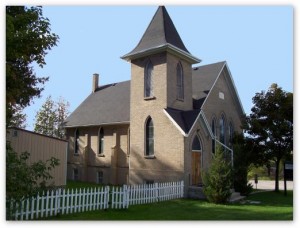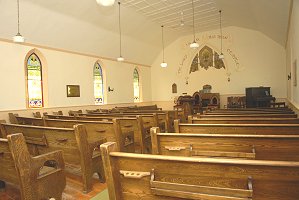About Maud
LUCY MAUD MONTGOMERY wrote 11 of her 22 novels at home in rural Leaskdale, Ontario, north of Uxbridge. Her personal journals tell her story. Her poetry reflects her feelings. Here she wrote… and here she dreamed. The Leaskdale Manse was the first home the author could call her own. In 1911, L.M. Montgomery moved to Leaskdale, a prosperous farming community, soon after marrying Ewan Macdonald. He was a Prince Edward Islander who had become the community’s Presbyterian minister one year earlier. Montgomery lived at the Manse for 15 years and raised 2 sons, Chester and Stuart. Her journals paint this period as full and happy. A gifted story-teller, Montgomery nurtured her literary talent against the backdrop of the rolling hills of rural Ontario, ensconced in her limestone-bricked, vernacular-style house. The spiritual beauty of the landscape stoked her creativity. Her garden gave her great joy and a sense of serenity. Her home provided comfort. The Leaskdale Manse holds the author’s memory and spirit. The story of this remarkable woman is waiting to be told.
Lucy Maud Montgomery was made an Officer of the Order of the British Empire by King George in 1935. She was also a Fellow of the Royal Society of Arts and Letters of England, a member of the Canadian Author’s Association, the Canadian Women’s Press Club, and the Literary and Artistic Institute of France, which presented her with a silver medal for her literary style.
Her Canadian Heritage Moment:
Lucy Maud Montgomery’s Heritage Minute
The Leaskdale Years
L.M. Montgomery came as the bride of Ewan Macdonald, the minister of St. Paul’s Presbyterian Church, Leaskdale, in 1911. She was already famous, having published Anne of Green Gables three years before. The village was agog, and welcomed her with enthusiasm. The Leaskdale Church, only 5 years old when she came to the community, was a small country church, but well designed and built, with beautiful stained glass windows, and polished pews. Ewan’s congregation had two sections, Leaskdale and Zephyr. She describes the Leaskdale congregation as being “all quite nice, being for the most part well-to-do farmers”.
Of the manse she writes in her journal:
“[the manse] is quite prettily situated. It is not an ideal house by any means, but it will do, and it is certainly much more comfortable and convenient than my old home. It is built of white brick in the ugly ‘L’ design so common among country houses. My greatest disappointment in connection with it is that it has no bathroom or toilet. I had hoped that I might have a home with these at least. But what is to be will be! It is Allah! We must submit!”
From the Selected Journals of L.M. Montgomery Vol. II page 82
September 27, 1913 [after a visit to Cavendish, P.E.I]
“Up to the very moment of getting here I was not reconciled to coming back. The drive from Uxbridge home depressed me. The air seemed dull and languid after the tang of the gulf breezes. But when our gate shut behind us it vanished. I was suddenly glad to be back – to be home! Glad to see again my garden, grown out of all recognition in my absence, glad to see my flowers, gray Daffy, my books and pictures, my own comfortable room. My house looked pretty nice to me. I saw it with a stranger’s eye after my absence and when my impression of it was not blurred by familiarity, I liked it! Yes, it was good to be home again among all my own household gods.”
From The Selected Journals of L.M. Montgomery Vol. II page 132
Maud and Ewan’s sons, Chester and Stuart, were born in Leaskdale, in the upstairs master bedroom. Another son, Hugh, was stillborn, and is buried in the cemetery at the Thomas Foster Memorial, south of Leaskdale. While living in the village of Leaskdale, Montgomery wrote eleven of her twenty-two novels.
Thursday, October 5, 1916
“Today I finished Anne’s House of Dreams. I never wrote a book in so short a time and amid so much strain of mind and body. Yet I rather enjoyed it and I think it isn’t too bad a piece of work. I am glad it is done however. It has taken a lot out of me.”
From The Selected Journals of L.M. Montgomery Vol. II page 193
While they lived in Leaskdale, Ewan Macdonald began to show symptoms of what was known as religious melancholia. He experienced severe headaches. “…for the most part he sat or lay in gloomy silence. He was so utterly unlike himself that he seemed to me like a stranger. He never took the slightest notice of the children and seemed to have absolutely no interest in them or anything…”
From The Selected Journals of L.M. Montgomery Vol. II page 323
Montgomery’s years in Leaskdale were rich in joy and sorrow for her. It was here that she lived some of her happiest times as a wife and mother, even during the war. She had a healthy husband and an intact young, loving family, the support of her beloved companion Frede, and a community that appreciated and admired her. She would never forget her friends’ sorrows at the loss of their grown children in the Great War or the wooded haunts that might have inspired the environs of Rainbow Valley. When the time came for her to leave Leaskdale, she wrote “The beautiful woods behind Mr. Leask’s, the leaf-hung corner of the side-road, the lovely hill field beyond with the elms on its crest. I love these things and grieve to leave them.”
From The Selected Journals of L.M. Montgomery Vol. III page 265
But more than that, it was the home that held her memories she grieved the most:
“I could hardly keep the tears back. That dark silent home seemed to be entreating me. ‘Oh, come to me. I am lonely. Though you have stripped and forsaken me I am still your home. I have things of yours here you can never find elsewhere – your children’s baby days, the ghosts of two little toddling lads – of Frede – come back – come back.’ And it was anguish to turn my back on it and go.” (Unpublished Journals, May 11, 1926)






